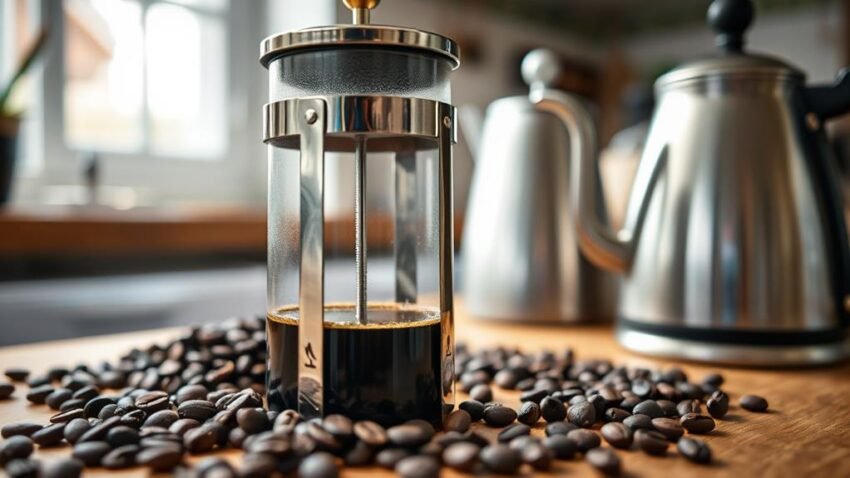I've spent years perfecting the art of brewing coffee without a filter, and it's been a game-changer for my daily coffee routine. If you're as coffee-obsessed as I am, you'll want to know the secrets behind these filter-free methods. From the classic French press to the more exotic Turkish coffee, there are several ways to enjoy your favorite brew without relying on a filter. But before you immerse yourself in these techniques, let's start with the basics—because trust me, once you try brewing without a filter, there's no turning back. So, are you ready to elevate your coffee experience?
Traditional Filter-Free Methods
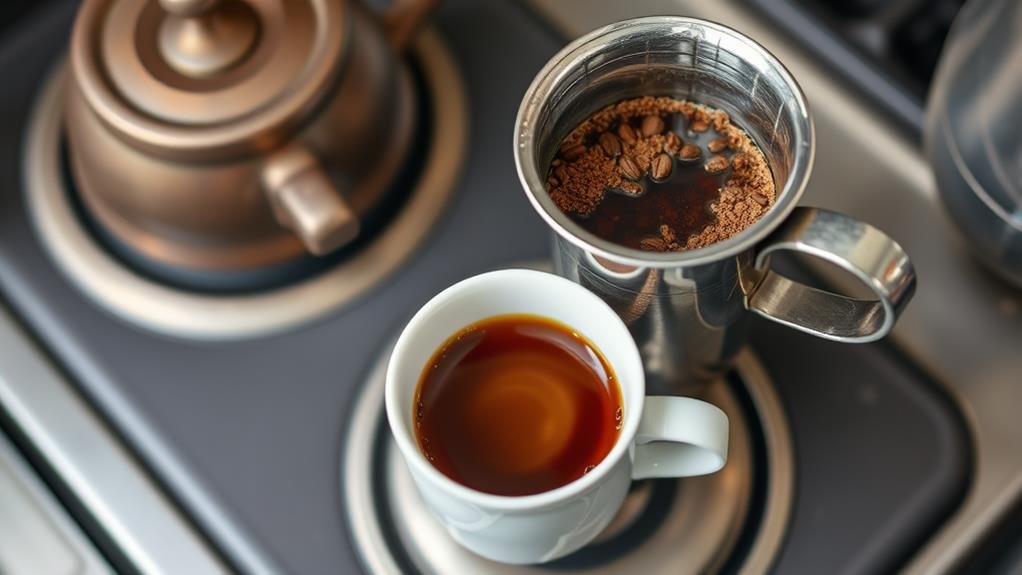
When it comes to brewing coffee without a filter, traditional methods offer a rich and flavorful alternative. One of the most popular is Turkish coffee, which involves boiling finely ground coffee with water in a cezve pot. This method ensures that all the flavor and oils from the coffee are extracted into your cup.
Another traditional filter-free method is French Press coffee. Here, you steep coarsely ground coffee in hot water and then press the plunger to separate the grounds from the liquid. This technique allows for a full-bodied flavor.
For those who prefer a more rustic approach, Cowboy Coffee is an option. It's made by boiling coffee grounds and water together in a saucepan, similar to how tea is brewed.
The Moka pot is another classic device that brews coffee by passing hot water through coffee grounds under pressure, resulting in a rich and flavorful cup.
Lastly, there's the AeroPress, which combines aspects of both French press and pour-over methods but without requiring a filter. These traditional coffee methods offer unique ways to enjoy filterless coffee, each with its own distinct character and process.
Cold Brew Coffee Technique
Cold brew coffee is a unique and invigorating way to enjoy your morning coffee without the need for a filter. This method involves steeping coarse coffee grounds in cold water for an extended period, typically 12-24 hours, which allows for a rich extraction of flavors. The ideal brewing ratio for cold brew is usually 1:4 or 1:8, depending on how strong you prefer your coffee.
To prepare cold brew, start by adding the coarse coffee grounds to a container filled with cold water. After the steeping process, you'll need to strain the mixture to remove the grounds. Using cheesecloth or a fine mesh strainer is effective for this step. Once strained, you have a concentrated cold brew that can be diluted with water or milk to achieve the desired strength and flavor.
Experimenting with different brewing ratios and steeping times can help you find your perfect cup of cold brew coffee. Diluting the concentrate allows for a smooth and invigorating drink that's perfect for any time of day. Overall, cold brew offers a versatile and flavorful way to enjoy coffee without relying on filters.
French Press Brewing
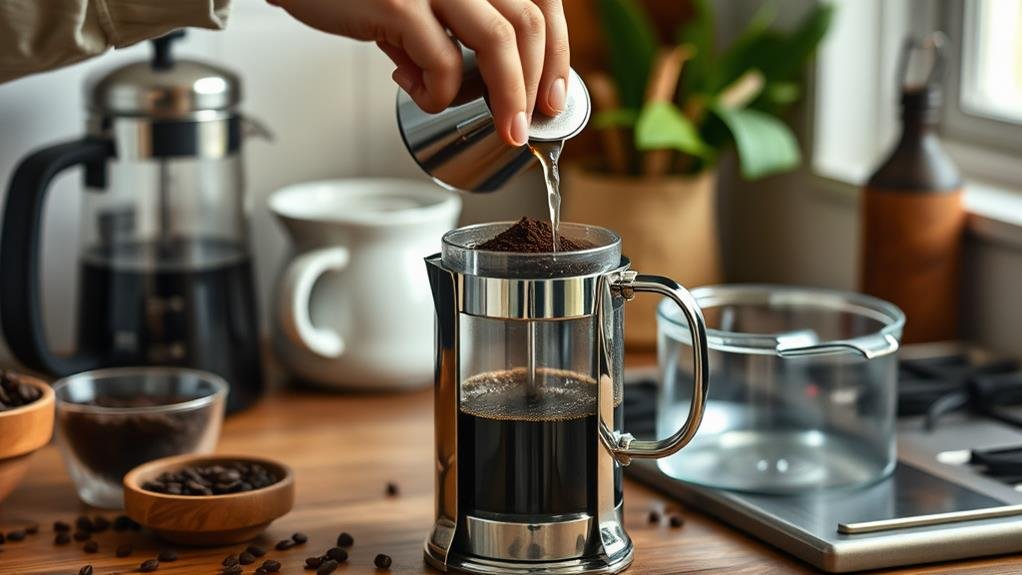
French press brewing stands out for its simplicity and rich flavor profile, making it a favorite among coffee enthusiasts. This method involves steeping coarsely ground coffee in hot water, which allows for full immersion brewing. This process extracts oils and flavors from the coffee grounds, resulting in a robust body and depth of flavor that is hard to achieve with traditional filter coffee.
Here's a step-by-step guide to brewing coffee using the French press method:
- Add Coffee Grounds: Place coarsely ground coffee into the French press.
- Pour Hot Water: Pour hot water over the coffee grounds.
- Steep: Allow the mixture to steep for 4-5 minutes.
- Press: Press down the plunger to separate the grounds from the brewed coffee.
This method offers a convenient way to enjoy a flavorful cup of coffee without requiring paper filters. The immersion brewing technique guarantees that all the desirable oils and flavors are extracted, giving your coffee a richer taste compared to filtered coffees. Overall, French press brewing is an excellent choice for those who want a full-bodied cup with minimal effort.
Turkish Coffee Preparation
Preparing Turkish coffee is an art that demands precision and patience. To start, you'll need finely ground coffee and a traditional cezve pot, which is specifically designed for brewing this type of coffee. The traditional method involves boiling water with the finely ground coffee and sometimes sugar in the cezve pot. This unique brewing process is what gives Turkish coffee its strong flavor.
As you boil the mixture, a foam will form on top, which is an important part of Turkish coffee's taste and presentation. Once the coffee has reached boiling point and the foam has formed, remove it from the heat. It's essential not to stir Turkish coffee after it has settled; this guarantees that the grounds remain at the bottom of the pot.
Pour the coffee into small cups, making sure to include some of the foam on top. This way, each cup retains that characteristic layer of foam that enhances both the flavor and visual appeal of Turkish coffee. With its strong flavor and distinctive brewing technique, Turkish coffee offers a unique coffee experience that stands out from other brewing methods.
Cowboy Coffee Method
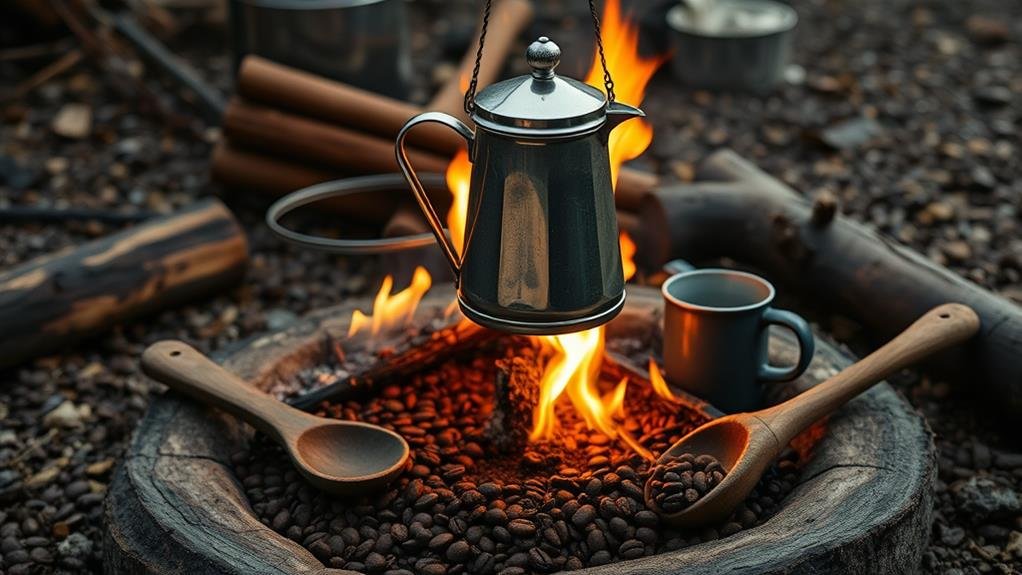
When it comes to brewing coffee without a filter, one of the simplest and most rustic methods is the cowboy coffee method. This traditional technique, which dates back to the Old West, involves boiling water with coffee grounds directly in a pot. Here's how you can try it:
- Add Coffee Grounds: Pour a generous amount of coffee grounds into your pot.
- Add Boiling Water: Pour boiling water over the coffee grounds, ensuring all grounds are saturated.
- Allow Settling: Let the mixture sit for a few minutes until the grounds settle to the bottom of the pot.
- Serve: Carefully pour the coffee into your cup, leaving the grounds behind.
This filterless brewing method offers a strong, bold flavor that many coffee enthusiasts appreciate. The simplicity of cowboy coffee is part of its charm; it requires no special equipment beyond a pot and some patience. As the grounds settle to the bottom, you're left with a rich and robust brew that's free from any need for filters or complicated brewing devices. This rustic brew captures the essence of simplicity in coffee-making, making it a favorite among those who value straightforward, uncomplicated flavors.
Moka Pot Brewing Guide
To start brewing with a Moka pot, you first need to assemble the device by attaching the bottom chamber, filter, and top chamber. Once assembled, you'll begin the brewing process by adding water to the bottom chamber and medium-ground coffee to the filter. This setup allows hot water to pass through the coffee grounds under pressure, creating a rich and bold coffee.
Moka Pot Assembly
Assembling the Moka Pot is a straightforward process that requires some basic steps. Let's break it down so you can get started right away.
- Fill the bottom chamber with water: Make sure to use fresh, cold water for the best flavor.
- Add finely ground coffee to the filter basket: The coffee should be evenly spread but not packed too tightly.
- Screw the top and bottom chambers together: Guarantee a secure seal to allow the brewing process to work properly.
- Place the Moka Pot on a stovetop at medium heat: This will help the water boil and pass through the coffee grounds effectively.
Brewing Process
Now that your Moka Pot is assembled, it's time to start brewing. The brewing process involves a few simple steps that yield a rich and flavorful coffee. First, fill the lower chamber of the Moka Pot with water. Next, place the coffee grounds in the filter basket, which is usually located in the middle chamber. Make sure not to pack the grounds too tightly, as this can affect the flow of water.
Once everything is in place, put the Moka Pot on your stovetop over medium heat. As the water in the lower chamber begins to boil, steam pressure will force it through the coffee grounds in the filter basket and into the upper chamber. You'll hear a gurgling sound as this happens.
The coffee produced by a Moka Pot is strong and concentrated, similar to espresso but with a distinct taste. This makes it perfect for enjoying on its own or using in espresso-based drinks. The brewing process is relatively quick and straightforward, offering great flexibility since Moka pots come in various sizes to suit different brewing needs. With these steps, you're ready to enjoy your Moka Pot coffee.
AeroPress Coffee Making
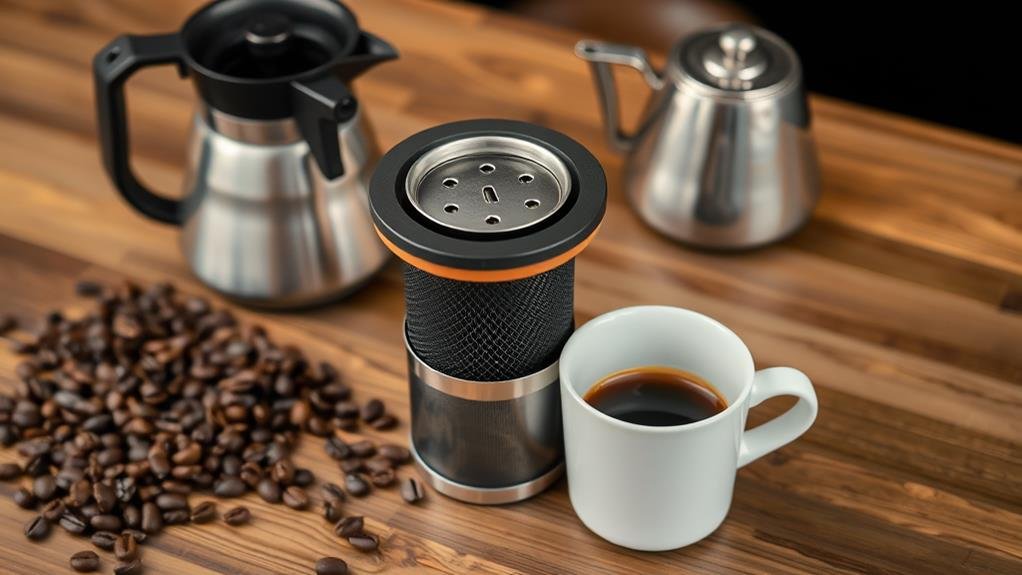
When it comes to brewing coffee without a filter, the AeroPress stands out as a versatile and efficient option. This portable brewing device is designed to extract rich flavors from coffee grounds using pressure, resulting in a smooth and flavorful cup of coffee in a short amount of time.
The AeroPress is ideal for single cup brewing, making it perfect for both home and travel use. Here are some key benefits that make the AeroPress a favorite among coffee enthusiasts:
- Convenience: The AeroPress is quick to use and clean.
- Versatility: It can produce a variety of coffee styles, from espresso to tea.
- Travel-friendly: Its compact size makes it easy to pack.
- Quality: The pressure method rivals traditional filter brewing in terms of taste.
The ease of cleaning and the compact design of the AeroPress contribute to its popularity. Whether you're brewing at home or on the go, this device ensures you get a high-quality, flavorful cup every time. Its ability to produce such rich flavors without requiring a filter makes it an excellent choice for those seeking to brew coffee efficiently and effectively.
Homemade Filter Alternatives
If you don't have a dedicated coffee brewing device like the AeroPress, there are still effective ways to brew coffee without a traditional filter. One of the most versatile options is using homemade filter alternatives. For instance, you can use a paper towel over the filter basket in your coffee machine as an alternative filter. This method works surprisingly well and is a great makeshift solution.
Another option is to use cheesecloth or a handkerchief to cover the filter basket or container. These materials provide a fine mesh that allows coffee to pass through while holding back the grounds. Similarly, you can use a clean sock as a DIY filter substitute by adding coffee grounds and pouring hot water over them.
Reusable tea bags filled with coffee grounds can also serve as a filter. Simply place the grounds in the tea bag and brew as you would with regular tea. These methods offer practical solutions when you're without traditional filters, allowing you to enjoy freshly brewed coffee without any hassle. Whether you're using cheesecloth, a clean sock, or reusable tea bags, these homemade filter alternatives make brewing coffee possible anywhere.
Serving and Customizing Tips
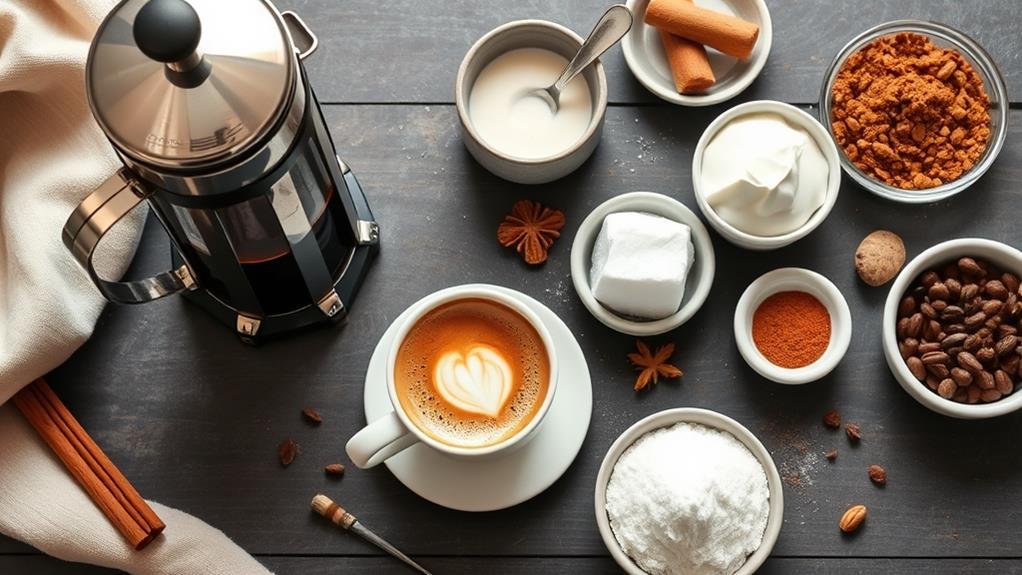
When serving and customizing your filter-free coffee, you have several options to enhance the flavor. I like to add milk, froth, or sugar to suit my taste preferences, which can greatly elevate the experience. Additionally, experimenting with different serving temperatures and dilution levels allows for a personalized cup of coffee that meets your specific needs.
Flavor Enhancement Tips
To elevate your coffee game, consider layering in some extra flavors and textures. Here are a few tips to get you started:
- Add Frothed Milk or Flavored Syrups: Frothed milk can add a creamy texture, while flavored syrups like hazelnut or caramel can introduce rich, sweet flavors.
- Experiment with Spices: Spices such as cinnamon or nutmeg can add a warm and inviting twist to your coffee.
- Try Different Milks: Almond milk, oat milk, and coconut milk offer unique flavor profiles and textures that can enhance your coffee experience.
- Adjust Sweetness Levels: Use sugar, honey, or agave nectar to find the perfect sweetness for your taste.
For an extra special touch, you can also incorporate ingredients like vanilla extract into your brew. Whether you prefer your coffee hot with a dollop of whipped cream or served over ice for a revitalizing drink, these enhancements allow you to customize it to your liking. By experimenting with these options, you'll be able to create a personalized coffee that suits your palate perfectly.
Milk and Sugar Options
Adding milk and sugar to your coffee can greatly enhance the flavor and strength to your liking. When it comes to customizing your coffee, experimenting with different types of milk is a great place to start. You can choose from whole, skim, almond, or oat milk, each offering a unique taste experience. For those looking to reduce calories, sugar alternatives like honey, agave, or stevia are excellent options for sweetening your coffee without adding extra calories.
The key to achieving the perfect cup is adjusting the milk-to-coffee ratio. This allows you to customize the creaminess and richness of your coffee according to your preferences. It's important to stir in the milk and sugar after the coffee grounds have settled to avoid disrupting the brewing process. This guarantees a smooth texture in every sip.
Customizing Strength Levels
Customizing the potency of your coffee is as simple as tweaking a few key variables. When brewing coffee without a filter, you have several options to adjust the potency to your liking.
- Adjust the coffee-to-water ratio: A higher ratio means more coffee grounds for every cup of water, resulting in a more potent brew.
- Steep the grounds longer: Steeping the coffee grounds for a longer period can create a more pronounced flavor.
- Dilute with hot water: If your coffee turns out too potent, you can dilute it with hot water to create a milder cup.
- Experiment with brewing times: Finding the best brewing time is optimal. Different times will yield different potencies.
Adding milk or cream can also help adjust the potency of your coffee by diluting it slightly while adding flavor. Unlike brewing with paper filters, brewing without one allows you to customize directly from the grounds themselves, giving you more control over how strong your coffee tastes.
Conclusion
Brewing coffee without a filter offers a rich and varied experience. By exploring methods like French press, Turkish coffee, cowboy coffee, and AeroPress, you can discover unique flavors and textures. Each technique has its own set of steps and benefits, allowing you to choose the one that best suits your taste preferences and brewing style. Experimenting with these methods can enhance your coffee enjoyment, making every cup a delightful adventure in flavor.

